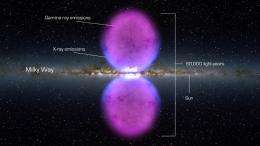Giant gamma ray bubbles in our galaxy

(PhysOrg.com) -- Gamma rays are the most energetic form of light, typically about one hundred billion times as energetic as optical light.
Gamma rays are produced in four main ways: in extremely hot regions (temperatures of more than about 100 million degrees), when very fast moving charged particles interact with other charged particles or with magnetic fields, when atomic particles or nuclei decay, or when matter and anti-matter annihilate. Although they are fantastically energetic, gamma rays from astrophysical objects are very difficult to detect because the atmosphere absorbs most of them, while telescopes in space need to use special techniques of particle physics because normal lenses or mirrors cannot focus high energy light.
CfA astronomer Doug Finkbeiner, together with two of his students, Meng Su and Tracy Slatyer, used NASA's Fermi Gamma Ray Telescope to study the diffuse gamma ray emission -- a haze that Fermi sees across the sky. Other satellites operating over a wide range of wavelengths, including in particular infrared and radio wavelengths, had earlier spotted what seemed to be a faint haze centered on the nucleus of our Milky Way galaxy. That more localized emission has been interpreted as being produced by charged particles moving in a magnetic field. If true, those particles could also produce faint gamma ray structures buried within the haze seen more widely across the sky.
After meticulous modeling of the spatial structure of the large scale, diffuse gamma ray emission, the CfA astronomers subtracted it from the images to search for possible small scale structures. Their dramatic discovery: two humongous bubbles of high energy emission protruding about 50,000 light-years above and below the galaxy, and centered on its nucleus.
Since our Milky Way's center contains a black hole with a mass of about thirty million solar masses, the scientists argue that the bubbles were produced either by an eruption from the black hole sometime in the past, or else by a burst of star formation in that vicinity. More research is needed to sort out these and other alternatives, but whatever the conclusions, the discovery of these giant gamma ray lobes helps us better understand the environment of our own home galaxy, while also probing the dramatic activities of the massive black holes found at the centers of most galaxies.
Provided by Harvard-Smithsonian Center for Astrophysics










.jpg)








